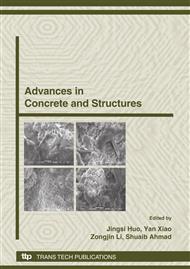p.347
p.355
p.363
p.371
p.379
p.385
p.391
p.395
p.403
Development of Lightweight Aggregate Concrete Containing Pulverized Fly Ash and Bottom Ash
Abstract:
This study examines the feasibility of using different lightweight aggregates (LA) and bottom ash as coarse and fine aggregates in concrete with fly ash. The lightweight materials were composed of 3 types, namely pumice, cellular lightweight aggregate and MTEC lightweight aggregate. The tests for physical and mechanical properties of lightweight aggregate concretes (LWAC) were conducted in terms of workability, compressive strength, apparent density, abrasion resistance and absorption. Test results showed that compressive strength of LWAC increased with an increase in apparent density, which is mainly depending on the type of aggregate. The replacement of normal weight sand with bottom ash resulted in a decrease both in density of concrete by 180-225 kg/m3 and 28-day compressive strength of concrete by 16-26%. Moreover, the use of bottom ash to replace sand in concrete increased the demand for mixing water due to its porosity and shape and to further obtain the required workability. The type and absorption of LA influenced predominantly the water absorption of LWAC. Total replacement of natural sand by bottom ash increased the absorption of the concrete by 63-90%. With regard to abrasion resistance, the abrasion resistance of lightweight aggregate concrete was mainly dependent on the compressive strength of concrete: the higher the strength, the higher the abrasion resistance of LWAC. In addition, the use of bottom ash as a fine aggregate resulted in a lower abrasion resistance of lightweight aggregate concrete due to its porosity. Of the three types of lightweight materials, MTEC LA had achieved both low density and high compressive strength.
Info:
Periodical:
Pages:
379-384
Citation:
Online since:
October 2008
Authors:
Price:
Сopyright:
© 2009 Trans Tech Publications Ltd. All Rights Reserved
Share:
Citation:


